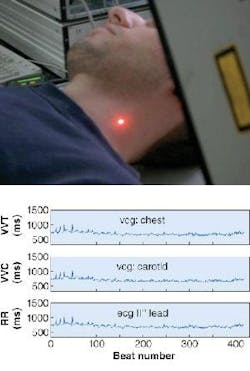Italian researchers have developed an optical technique for noncontact heart monitoring based on laser Doppler vibrometry (LDV) that could become an alternative to electrocardiography (ECG). They report that clinical trials are showing high correlations when the two methods are used simultaneously.
A laser-based vibration-displacement and velocity measurement technique, LDV allows the examination of cardiovascular dynamics, according to Lorenzo Scalise of Enrico Tomasini’s LDV research group at Universita Politecnica delle Marche (Ancona, Italy). The group is working with Mauro Grigoni of the Italian National Institute of Health on clinical trials. The LDV technique may accurately measure point-by-point surface velocities using interferometric techniques. These systems usually work at a maximum frequency in the range of tens of megahertz, and with a lower limit of less than one hertz. The laser sensor, a HeNe laser source (632.8 nm, less than 1-mW output power), performs velocity measurements with a resolution up to 0.5 µm/s, according to Scalise.
“An advantage of this approach is that it provides a noncontact method to measure the compression waves that are transmitted to the chest wall, to assess the monitoring of the patient’s vital signs,” Scalise says.
In the experimental procedure, one laser head was placed about 1 m from the subject chest wall and the second laser head at the same distance from the carotid zone (see figure). Short-term recordings (5 min) were carried out on five healthy human subjects (aged 21 to 37 years) in a resting position on a bed. The output signals, provided as voltage, were converted to a velocity signal at a sensitivity of 20 mm/s/V. Because of the low power, no special safety measures were required.
Vibratory and ECG signals from the chest wall and carotid were simultaneously recorded. The ECG was connected in the ordinary configuration for the recording of the three fundamental leads. The analog inputs were sampled at 1 kHz. The data showed no significant statistical difference between the two procedures.
Scalise says the trials proved that VCG can obtain the same information as ECG while retrieving physiological quantities characterizing the cardiac activity. It can provide the patient’s breath frequency and heart sounds that relate to the heart’s mechanical function. VCG can analyze the opening and closing of heart valves, as well as ejection and filling processes within the ventricles.
Scalise says the noninvasive LDV approach could enable remote monitoring of burn victims who cannot be touched, and in other cases in which electrodes cannot be applied to the skin without endangering the patient. It also eliminates concerns about electromagnetic interference that can cause errors in ECGs or inaccurate readings obtained from poorly located ECG patches.
“The system is patent pending (European Patent Office) and we are in contact with three major European medical device companies for the commercialization of the patent,” Scalise said. “We are also looking for the opportunity to present the technique to other companies.”
